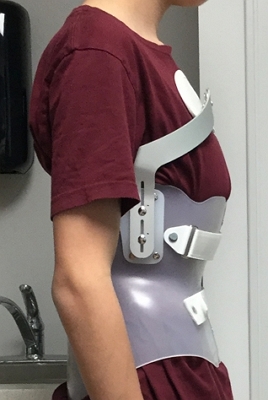Of these options, The LA Kyphosis Brace™ represents the most technically advanced and most effective design of Kyphosis brace. Orthotists can order The LA Kyphosis Brace on the opHUB BES.T Marketplace. It requires the use of the TorsoCAD Windows app for data acquisition.
Kyphosis Information
Who Gets Kyphosis?
Everybody has Kyphosis, this terms anatomically refers to the natural forward bending curve in the thoracic spine. when we refer to Kyphosis medically we are often actually referring to Hyper-Kyphosis. People of all ages can have Kyphosis, but is most prevalent among adolescent children where it is referred to as Scheuermann’s Kyphosis. Adolescent idiopathic Scheuermann’s Kyphosis occurs after the age of 10. Boys are more likely than girls to have this type of spinal deformity. Early onset or infantile Kyphosis occurs in children less than 3 years old. Juvenile Kyphosis occurs in children between the ages of 3 and 10.
What Causes Kyphosis?
In 80 to 85 percent of people, the cause of Kyphosis is unknown; this is called idiopathic Kyphosis. Before concluding that a person has idiopathic Kyphosis, the doctor looks for other possible causes, such as injury or infection. When a Kyphosis presents in a child and there is vertebral wedging present then it usually referred to as Scheuermann’s Kyphosis.
What is Kyphosis?
Kyphosis is a problem that causes your spine to deviate from its ‘normal’ alignment resulting in a structural deformity. Unlike Scoliosis which can can have up to four components, Kyphosis is typically uni-planar in that it is a deviation in one plane only..There are however 3 components of a true Scheuermann’s Kyphosis which are: Thoracic Hyper-Kyphosis; Lumbar Hyper-Lordosis; and Swayback The most obvious deformity is the Thoracic Hyper-Kyphosis. The universal method of measurement of deformity is the “Cobb angle”, which measures the degree of curvature created by the Kyphosis. In some case Kyphosis can be present with Scoliosis, particularly a Lumbar Scoliosis.
Why Treat Kyphosis?
A significant Kyphosis that is untreated can get worse as you grow and could cause problems in later life. As a Kyphosis develops your body will show more and more signs of the deformity as you develop a rib hump on your back. If the Kyphosis develops too far, you will need to have a big surgery to correct your spine that will also reduce your spinal flexibility. There are no specific indicators that determine whether or not a given curve will progress.
The larger the curve is and the younger the child the greater the risk of progression. Curves progress most rapidly during the growth spurt, which is usually between 11-13 years in girls and 13-15 years in boys. However these are just rough estimates and the growth spurt can occur earlier or later
The international Society on Scoliosis Orthopedic and Rehabilitation Treatment (SOSORT), a leading scientific medical society on scoliosis, in 2006 composed and published a consensus papers on ?Why do we treat adolescent idiopathic scoliosis? The consensus paper, compiled the following list:
1-Aesthetic Longevity – Achieving more symmetrical body/torso appearance
2-Quality of Life – Maintaining normal daily living activities
3-Back Pain – Minimizing the impact of chronic back pain
4-Psychological Well -Being -Feeling comfortable in one’s body despite spinal deformity
5-Progression in Adulthood – Alter the natural course of progression into adulthood
6-Treatments into Adulthood – Creating treatments for adults that can be performed at home
7-Breathing Function – Maintaining optimal body oxygenation
8-Radiographic and Clinical Data – Symmetry of the spine on x-ray
9-Posture, Balance, and Movement – Symmetry of visual posture and maintaining balance
10-Cognitive – Preventing mental decline from brain asymmetries
Treatment Options
Many conservative treatment systems advertised on the internet may claim to “correct” Kyphosis. Be wary of these un-proven claims. To date the only treatment conclusively proven to actually correct a Kyphosis is surgery. Studies have been done on Kyphosis treatment and the medical community has been able to conclude that conservative treatment can prevent a Kyphosis from getting worse and that the most effective conservative treatment modality is rigid bracing. Nevertheless, the newer more modern bracing designs such as The LA Kyphosis Brace™ are starting to show some signs of regression of curves, particularly when combined with the Schroth therapy method (see www.schrothmethod.com). As more and more patients receive these treatments, more evidence is tabulated and eventually it will be determined scientifically if these advanced conservative treatment options can claim to “correct” Kyphosis.
Bracing Options
Bracing systems for scoliosis fall into three categories:
- Milwaukee/Superstructure Braces.
- Symmetrical “Static” Rigid Braces with Correction Pads. Boston Kyphosis Brace, Wilmington Brace
- Hyper-Corrective Adjustable Braces – The LA Kyphosis Brace, Kyphologic Brace


